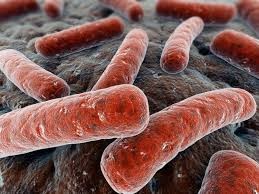I was inside a Keke Napep (Tricycle) going home from work, the driver picked another passenger. I didn’t mind until the woman started coughing profusely without covering her mouth and was throwing unseen bacterium all around, I couldn’t see the bacteria but I knew they were definitely there, but what I couldn’t tell was what kind of bacteria was it. I got scared and had to cover my mouth and nose with my veil hoping it wasn’t Mycobacterium Tuberculosis.
Mycobacterium Tuberculosis is a bacterium that causes Tuberculosis, it resides mainly in the lungs but sometimes are seen elsewhere. It is one of the most patient bacteria as it can wait a long time to strike.
Tuberculosis (TB) is a potentially serious infectious disease that mainly affects lungs. Mycobacterium Tuberculosis are spread from one person to another through tiny droplets release into the air via cough and sneezes. Many strains of tuberculosis resist drugs most used to treat the disease. People with active tuberculosis must take several types of medications for many months to eradicate the infection and prevent development of antibiotic resistance.
Symptoms
Although the body may harbor mycobacterium tuberculosis, the immune system usually can prevent a person from becoming sick. For this reason, doctors make a distinction between:
- Latent TB. In this condition, you have a TB infection, but the bacteria remain in your body in an inactive state and cause no symptoms. Latent TB, also called inactive TB or TB infection, isn’t contagious. It can turn into active TB, so treatment is important for the person with latent TB and to help control the spread of TB in general.
- Active TB. This condition makes a person sick and can spread to others. It can occur in the first few weeks after infection with the TB bacteria, or it might occur years later. Signs and symptoms of active TB include:
- Coughing that lasts three or more weeks
- Coughing up blood
- Chest pain, or pain with breathing or coughing
- Unintentional weight loss
- Fatigue
- Fever
- Night sweats
- Chills
- Loss of appetite
Tuberculosis can also affect other parts of the body, including kidneys, spine or brain. When TB occurs outside the lungs, signs and symptoms vary according to the organs involved. For example, Tuberculosis of the spine may give back pain, and Tuberculosis in the kidney might cause blood in the urine. It is advised to see the doctor immediately when these symptoms appear.
Complications
Without treatment, Tuberculosis can be fatal. Untreated active disease typically affects the lung but it can spread to other parts of the body through the bloodstream.
Examples of tuberculosis complications include:
- Spinal pain. Back pain and stiffness are common complications of tuberculosis.
- Joint damage. Tuberculous arthritis usually affects the hips and knees.
- Swelling of the membranes that cover brain (meningitis). This can cause a lasting or intermittent headache that occurs for weeks. Mental changes also are possible.
- Liver or kidney problems. The liver and kidneys help filter waste and impurities from the bloodstream. These functions become impaired if the liver or kidneys are affected by Tuberculosis.
- Heart disorders. Rarely, tuberculosis can infect the tissues that surround your heart, causing inflammation and fluid collections that may interfere with your heart’s ability to pump effectively. This condition, called cardiac tamponade can be fatal
Treatment
- Medications are the cornerstone of tuberculosis treatment. But treating TB takes much longer than treating other types of bacterial infections.
- With tuberculosis, a person must take antibiotics for at least six to nine months. The exact drugs and length of treatment depend on the age, overall health, possible drug resistance, the form of TB (latent or active) and the infection’s location in the body.
Prevention
If you have active TB, keep your germs to yourself. It generally takes a few weeks of treatment with TB medications before you’re not contagious anymore. Follow these tips to help keep your friends and family from getting sick:
- Stay home. Don’t go to work or school or sleep in a room with other people during the first few weeks of treatment for active tuberculosis.
- Ventilate the room. Tuberculosis germs spread more easily in small closed spaces where air doesn’t move. If it’s not too cold outdoors, open the windows and use a fan to blow indoor air outside.
- Cover your mouth. Use a tissue to cover your mouth anytime you laugh, sneeze or cough. Put the dirty tissue in a bag, seal it and throw it away.
- Wear a mask. Wearing a surgical mask when you’re around other people during the first three weeks of treatment may help lessen the risk of transmission.
In countries where tuberculosis is more common, infants often are vaccinated with Bacille Calmette-Guerin (BCG) vaccine.
Asmau Ahmad is a young female microbiologist and leaves in Kano, Nigeria. She can be reached via asmeee@yahoo.com




